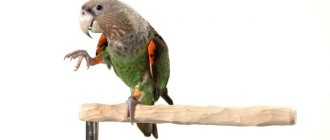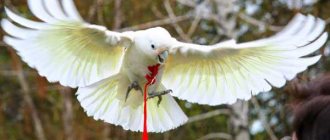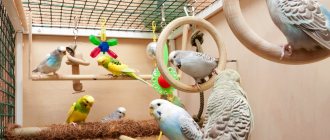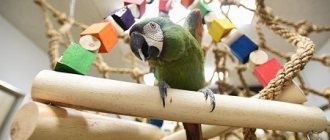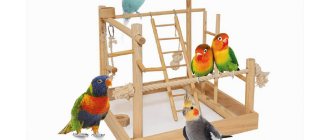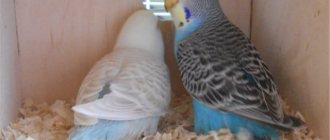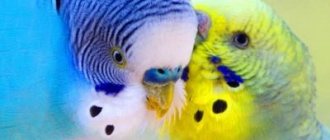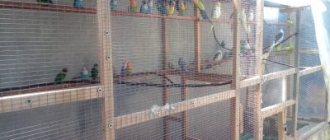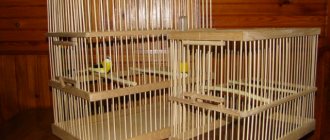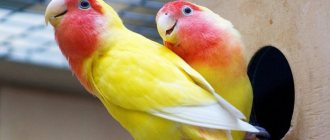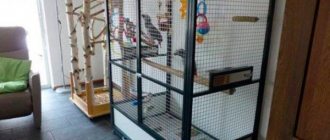- home
- Parrot
- Arrangement
05/23/2019 Parrots are very clean birds, so sometimes owners get to watch their pet use one or another container as a bath. This strange behavior is caused by the desire to satisfy the need for water procedures and hygiene. A parrot bathing suit can help with this need.
What can be used for bathing
In the absence of special devices, a regular water tap will do for the first time, but with some reservations. Not every parrot will agree to such radical bathing procedures. For example, budgerigars quite willingly splash under running water. While eclectus or grays will not even come close to it.
Here a lot depends on the breed and character of the bird itself. Some exotic individuals do not require bathing procedures at all: they are perfectly controlled by their beak, wetting it with water from the drinking bowl.
What can you use for bathing?:
Bath . One of the simplest and most affordable solutions. You can use almost any container suitable in size: a bath for hands, for paint, a container for food, or a specialized one for parrots.- Bathing suit . The best option for all representatives of parrots. Stores offer a wide range of shapes and sizes for any bird, from budget solutions to premium ones.
- Fountain . On sale you can find decorative devices for parrots in different designs. Suitable for all breeds.
- Spray bottle . Minimum hassle and investment. Pour water into a container, screw on the spray bottle and spray the pet's feathers. But it should be taken into account that some individuals do not accept this format of bathing in principle.
You cannot use containers made of cheap plastic or copper for bathing. Such materials emit fumes and oxides that are harmful to the animal.
other methods
There are more than 200 species of domestic budgerigars (unlike wild ones, of which there is one family). They differ not only in color and feather shape. Each bird has its own character and habits. Therefore, the parrot himself often makes it clear how he likes to swim. After experiments and observations, the owner can only accept his choice.
In addition to the traditional bath, there are a number of other ways to keep your pet clean.
Under running water
This is the easiest way to wash your parrot. It is used when the bird has perfectly adapted to the house and loves to accompany its owner in everything. If your pet is brave and curious, he will quickly master bathing under running tap water. This type of washing has a number of rules that must be followed:
- the water must be free of chlorine, a filter must be installed on the tap;
- first you need to set up warm water, then invite the bird to swim;
- keep the pressure low, the stream should be thin;
- do not hold the parrot under a stream of water; the bird itself sprays water and washes itself in the drops (or waits until the owner sprays the water).
A method that is effective is when the owner holds his hands under the stream and cups it in his palms. Tame parrots willingly bathe in such an improvised “pool”.
Bath with greenery
In nature, wild birds often bathe in dense grasses covered with dew. That’s why many pets love to take a bath with herbs. Options for such a bath can be different:
- Line the bottom of the container with lettuce leaves and pour water on top. The bird may peck the grass while washing.
- In the parrot’s usual bath, scatter several shoots of plants that he loves (use only fresh herbs).
- Make a bath only from grass. Place a thick layer of young greens in a suitable container, generously soaked in water. This method is especially good for parrots that dislike water or are shy.
It is important to know that not every herb is good for birds. There are harmful and poisonous types of greens that are contraindicated for parrots. List of plants that can be used:
- plantain;
- dandelion;
- carrot and beet tops;
- spinach;
- clover;
- nettle (previously scalded with boiling water);
- woodlice;
- wheat and barley sprouts.
These herbs can not only be added to the bath, but also introduced into the diet of pet parrots.
From time to time, it is useful for parrots to take baths from a weak decoction of chamomile or horsetail (you can alternate). They enrich the bird’s body with vitamins, improve digestion and have an anti-inflammatory effect.
Using a spray bottle
This method is often suitable for birds that refuse to approach a water bath. You need to choose a coarse spray model so that the water drops serve as artificial rain for the parrot. The washing rules are as follows:
- the water should be warmer than in a bathhouse, since when splashed, the drops cool quickly (optimal temperature +25°C);
- hold the shower above the bird’s head at a distance of 25-30 cm, creating the illusion of rain;
- do not apply too much pressure so that the water flows gently onto the body and does not frighten the parrot;
- If the bird washes itself in a cage, first remove food and excess toys (to allow room for wings to flap).
Bathing time in the shower is 5-7 minutes. If the parrot is keen on the procedure, you can extend it to 15 minutes.
In the purified sand
For such a bath you need to use special fortified sand. Regular river or sea will not work. The larvae of various insects and parasites that can harm the bird often “live” in it.
A layer of sand 1.5-2 cm high should be poured onto the bottom of a small container. The parrot climbs into it and cleans the skin and feathers there. Usually a sand bath is used in 2 cases:
- When a bird is terribly afraid of water (shy by nature or the first experience has turned into a phobia).
- In winter, when the room is cold. In such a situation, it is better for the parrot to wash in the sand than to catch a cold after water procedures.
You can throw familiar toys into the sand to make the cleaning process interesting and fun for the bird.
In talc
If the parrot is very shy, it is cleaned with baby powder with a talc base. Apply a little product to the plumage and rub it in carefully. At the end of the procedure, the powder is not washed off; the bird itself will clean it out over time.
When using “dry” methods, you should not give up trying to accustom your parrot to the bath. Carefully and delicately, you can instill healthy habits in your pet.
Types of baths
There are closed and open versions of swimsuits on sale. The former are more expensive, but they are more practical. In closed bathing suits for parrots, the water mostly ends up on the walls, and not on the interior items. Considering that some individuals become especially playful at the sight of water, this option will come in handy.
Closed options are attached to rods or other frame elements. They are suitable for large birds such as macaws, grays or amazon. In addition to fasteners, good products are equipped with a wooden or plastic ledge for a more comfortable grip . There are both internal and external models. It is more advisable to buy the latter for small cells.
Open bathing suits in the form of a bathtub are much cheaper. Naturally, during water procedures the pet will splash water. Therefore, the bath should be kept at the other end of the cage, away from the feeder. Such solutions are suitable for small birds, for example, budgies or lovebirds.
The bathing suit must correspond to the size of the parrot. If the container is deep, the pet may choke in it. Swimsuits that are too small will simply be useless for the bird.
Types of bathing suits for parrots
Special bathing suits for parrots are sold in pet stores. The choice of such products is quite large. They have different sizes, shapes, and differ in the method of fastening and design. They are made of safe plastic that does not emit toxic elements and plexiglass. The first ones are lighter and more convenient to use.
Types of bathing suits for birds:
- Open plastic baths of rectangular, square, round shape. Installed on the bottom of the cage or next to it. Some models have a side mount to secure the structure to the bars of the cage. Pros: affordable price, easy care of the product. Cons: Water may spill from an open container.
- Closed hanging baths with a transparent plastic lid and a side opening through which the bird can easily enter the bath. The structure is securely attached to the outside of the cage. Pros: easy to use, there is no risk of water spilling outside the bath. Cons: can only be attached to cages that have a special opening through which the parrot can enter the bath.
Choose a swimsuit based on the size of the bird. It must be wide enough to comfortably accommodate the parrot and be shallow, otherwise the parrot may accidentally choke during water games.
How to make it yourself
It’s quite possible to make a simple bathing suit for small and medium-sized parrots with your own hands. No specific skills are required here. As a key component, you can use a regular 5-liter water bottle - square or round.
Making your own swimsuit:
- We cut the container in half, making a cut slightly above the middle.
- We cut the neck to the beginning of the fold.
- We mark the bottom of the bottle, taking into account the size of the pet, and cut out the inlet hole.
- Insert the neck and make holes.
- Using ties or twine, we secure both parts of the structure.
- To prevent the bird from moving the bathing suit around the cage, you can place a stone inside.
To add water, simply unscrew the lid. Plastic is easy to maintain, but must be kept away from direct sunlight or it will warp. It should also be taken into account that some birds may be frightened by the “panoramic floor”. In such cases, you can put greenery on the bottom: branches or leaves, thereby creating an environment as close to natural as possible.
How often should you bathe your bird?
During the summer months, your parrot should have free access to water . On hot days, they can spend almost all the time in the bathing suit, which is normal. In this case, the water must be changed daily. You also need to monitor the temperature. Do not pour too cold water, at least +15°C, otherwise your pet will catch a cold.
During the cold season, you should limit the volume of water procedures to once or twice a month. Here, a lot depends on the microclimate in the room where the cage is located. If the air is dry, then the number of baths can be increased to 4-6 times a month.
How many parrots do you have?
12
And I'm afraid of water!
How to make a New Year's parrot costume with your own hands for a girl and a boy?
In principle, accustoming a feathered pet to water is not difficult. First, introduce the bird to a bath filled with water. Sit next to him, dip your fingers in the water and slowly move them in one direction or another. The parrot will closely monitor your actions
After some time, take water into your palm and carefully pour it over the back of the bird. If this does not throw her into panic, the desired goal will soon be achieved. The simplest and most effective way is to place a small container (this could be a deep plate made from a toy dish) with water in the wavy cage
We repeat: parrots are very curious, and your pet will definitely be interested in a new object. At first he will look closely and sniff, then he will dip his beak, try to climb in with his paws, and after some time he will eventually bathe entirely
The simplest and most effective way is to place a small container (this could be a deep plate made from a toy dish) with water in the wavy cage. We repeat: parrots are very curious, and your pet will definitely be interested in a new object. At first, he will look closely and sniff, then he will dip his beak, try to climb in with his paws, and after some time he will eventually bathe entirely.
The spray bottle as a method of bathing has already been mentioned above. But this item will also help rid your feathered pet of his fear of water: just spray the “water panty” through a spray bottle a couple of times a day.
Bathing rules
The condition of the pet must be taken into account. A sick bird should not be bathed at all. And during rehabilitation, it is better to remove the bath from the cage altogether. This also includes the period of adaptation to a new place of residence. You cannot force a parrot to take a bath . It takes parrots about a week to get used to people and their surroundings.
The bird itself will understand how to use the bath, that is, there is no need to accustom it to water procedures. If for some reason the bird ignores the bath, then you can put his favorite toys nearby. This way your pet will quickly get used to the new accessory.
The temperature in the room where the cage with the bathing suit is located should not fall below +20°C. If the parrot begins to tremble, while keeping its beak constantly open, then the water procedures must be stopped.
